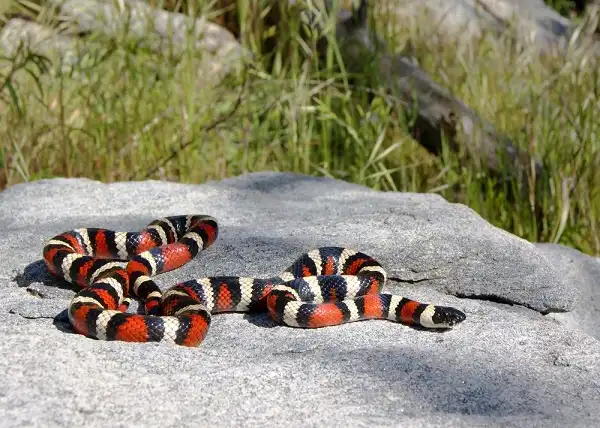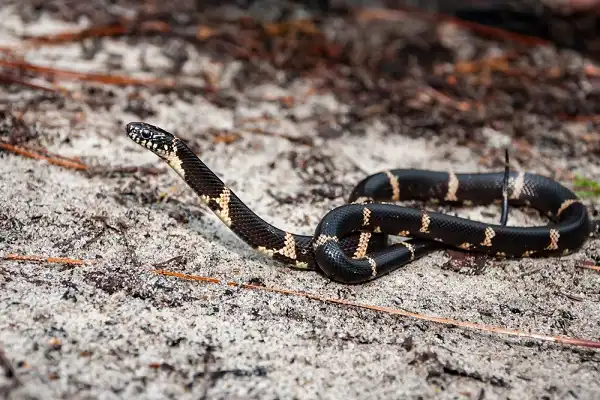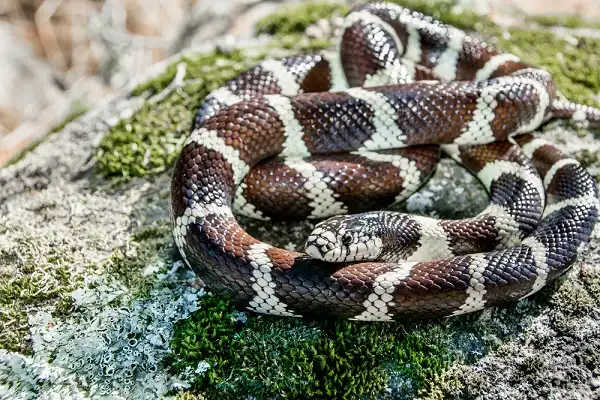Snakes are often feared and perceived as evil creatures. However, there are many different types of snakes, some of which are actually quite harmless. The king snake is one such example. In fact, king snakes are actually beneficial to have around, as they help control populations of smaller rodents. Here’s everything you need to know about these amazing creatures!

King Snake Description
King snakes are a species of non-venomous snake found all over the world. They are usually characterized by their colorful and patterned scales, which can range from black to yellow, brown, or even blue. Aside from size variations among different species and individual snakes, there are also color differences that can be observed. King snakes come in a wide range of colors including black, white, yellow, green, orange, blue, and even pink! These color variations help them blend into their natural environment and avoid becoming prey for predators.
King Snake Habitat
King snakes are found in a variety of habitats, depending on the specific species. They can be found in forests, deserts, grasslands, marshes, and even urban areas. Most king snakes prefer warm climates, as they are ectothermic (cold-blooded) and rely on the external environment to regulate their body temperature. In North America, species like the California king snake can be found basking in open desert areas with rocks that provide protection from predators. In South America and other tropical regions, king snakes enjoy densely wooded forests where they hunt for small rodents and lizards. King snakes can also be found in agricultural areas where they can feed off of pests like mice and rats which threaten crops. King snakes have adapted to a range of different environments due to their hardy nature and ability to eat a wide variety of prey items. Some species of kingsnake even live in urban areas where they prey on rats that have become accustomed to human contact. This has earned them the nickname “rat snake” amongst locals who appreciate their help in keeping rodent populations under control! Overall, king snakes make excellent habitats for many different ecosystems as they help keep rodent populations down while providing predators with ample food sources.
King Snake Diet
King snakes are not picky eaters and will feed on a variety of different prey items, depending upon their location and species. The most common prey item for king snakes is small rodents such as mice, rats, voles, and chipmunks. They may also consume lizards, amphibians, other snakes (including venomous species), birds, bird eggs, and even some insects such as caterpillars. In addition to hunting live prey, king snakes may also scavenge for dead animals or feed on carrion. This can be especially helpful during periods when food is scarce or hard to find due to extreme weather conditions such as drought or cold temperatures. When raising young, female king snakes may offer a regurgitated meal from their own stomach to their hatchlings in the form of a “brood” meal which helps them develop stronger foraging skills at an earlier age.

King Snake Size
King snakes come in a variety of sizes, ranging from small to large depending on the species. The smallest king snake species is the tiny Mexicali kingsnake which rarely grows beyond 18 inches in length. On the other end of the spectrum, some species can reach lengths of up to 8 feet or more! In addition to size differences between species, there are also variations between individuals within a single species. Males tend to be slightly larger than females and wild-caught adults will typically grow larger than those raised in captivity. Additionally, some subspecies may display more exaggerated physical characteristics such as a thicker body or longer tail than their counterparts in other locations. King snakes are slow growers and typically reach their full size at around three years old. After this point, they will continue to gain weight but not necessarily grow any bigger in terms of length.
King Snake Lifespan
The lifespan of a king snake can vary greatly depending on its species, gender, and whether it lives in the wild or captivity. Generally speaking, most species are known to live up to 20 years in the wild, with some individuals reaching much older ages. In captivity, however, the average lifespan of a king snake is typically much shorter due to poor husbandry practices and other environmental factors. Due to their hardy nature and variable sizes and colors which help them blend into their natural environment and avoid becoming prey for predators, king snakes have adapted very well over time and have been able to survive various changes in their habitats. As such, they provide an important role in pest control by helping keep rodent populations under control while providing predators with ample food sources; making them an integral part of the ecosystem and worthy of protection for future generations!
King Snake Behavior
King snakes have a variety of different behaviors depending on the species, environment, and individual. Generally speaking, they are primarily nocturnal animals that spend most of their time searching for food or shelter during the night and sleeping during the day. During the active periods, they will often be found basking in sunlight to regulate their body temperature and move around in search of prey. Additionally, they are known to be quite territorial and may defend an area from other snakes or animals by using musk-producing glands near their tails to mark their territory with a strong odor. When threatened, king snakes typically try to flee or hide rather than fight back; however, if cornered or provoked, they can be quite aggressive and may attempt to bite. This behavior is usually seen when wild-caught king snakes are handled by humans since they do not recognize them as a source of food or safety. Nonetheless, if provided with proper care and handling techniques over time, king snakes can become very tolerant of humans and some even enjoy being held!

King Snake Speed
King snakes are known for their impressive speed and agility, especially when in pursuit of prey. Depending on the species, they can reach speeds up to 15 mph (24 km/h) when chasing after small animals such as rodents or lizards. This makes them formidable predators and helps them capture their food with ease. In addition to their high speed, king snakes also have sharp reflexes which allow them to make quick turns and sudden stops while pursuing prey; this helps them to avoid obstacles in their path and maneuver around them quickly. Additionally, they have flexible bodies that enable them to traverse various types of terrain with ease; allowing them access to both open spaces and tight areas where rats and mice may hide. King snakes have a variety of adaptations that enhance their speed and agility in the wild. For example, they have strong muscles which help propel them forward at high rates of speed while their streamlined shape assists in reducing air resistance so they can move more efficiently through the air. Their scales are smooth yet tough which allows for increased traction on uneven surfaces as well as protection from bites or scratches from potential prey items. They also possess an advanced nervous system that responds quickly to environmental changes such as temperature shifts or movement of nearby animals; this allows them to react accordingly when hunting or trying to evade predators.
King Snake Hunting
King snakes are known for their skillful hunting abilities, which they use to search out and capture prey with great speed and accuracy. Typically, these skilled hunters will take advantage of any available opportunities to find food; foraging through tall grasses, under rocks or logs, inside crevices, or in any other tight spaces where rodents or insects may be hiding. When hunting, king snakes employ a variety of tactics that help them locate and capture their prey quickly. For instance, they can use their keen senses of smell and hearing to detect potential meals from a great distance away. Furthermore, they possess exceptional vision which allows them to pick out hidden animals even in dim light conditions. Additionally, their powerful muscles enable them to move quickly and launch powerful strikes at unsuspecting victims when the opportunity arises. Once a potential meal has been detected by the snake’s senses, it will launch itself into action—quickly approaching its target with impressive agility while maintaining its body close to the ground in order to reduce drag and maximize speed. Upon making contact with its intended victim, the snake will coil around or grab onto it with its jaws before constricting tightly in order to immobilize it. In doing so, king snakes have been known to capture meals up to three times larger than themselves!

Conclusion
The king snake is a remarkable creature that has adapted to survive and thrive in many varying environments. Its strength, speed, agility, and ability to search out hidden prey make it an impressive hunter capable of capturing meals up to three times its size. Furthermore, the combination of smooth scales, advanced senses, and muscular bodies enable king snakes to move quickly through their habitats with ease; allowing them access even tight spaces where rodents or insects may hide. Taken together these traits have enabled this species to maintain its place at the top of many food chains over time! As such, king snakes are truly worthy adversaries who should be admired for their impressive hunting abilities
Frequently Asked Question

